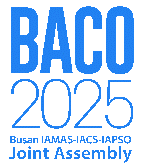Abstract for the Busan IAMAS-IACS-IAPSO Joint Assembly 2025
 Abstract for the Busan IAMAS-IACS-IAPSO Joint Assembly 2025
Abstract for the Busan IAMAS-IACS-IAPSO Joint Assembly 2025
Extratropical transition pathways of tropical cyclones and their role in storm intensity and destructiveness
Hung Ming Cheung(1), Ewha Womans University
Chang-Hoi Ho(2), Ewha Womans University
Jung-Eun Chu(3), City University of Hong Kong
Tropical cyclones (TCs) undergoing extratropical transition (ET) can lead to extensive impacts, yet the diversity in their evolutionary pathways remains only partially understood. This study examines TCs in the western North Pacific from 1979 to 2022, categorizing them into three ET pathways based on cyclone phase space: Type 1 (asymmetry increases prior to transition), Type 2 (cold-core development first), and Type 3 (direct transition). The analysis highlights distinct structural and environmental characteristics among these pathways. Type 1 undergoes the most pronounced asymmetry changes and retains the strongest surface winds, whereas Type 2 experiences smaller asymmetry changes and maintains a weaker wind field. Type 3, in contrast, remains relatively symmetric throughout transition and develops in a more baroclinic environment. Among the pathways, Type 1 exhibits the highest post-ET destructiveness. Sensitivity analysis shows that while most findings remain consistent across classification thresholds, Type 3 is particularly sensitive to threshold choice and requires cautious interpretation. These findings advance our understanding of the variability in ET processes and their implications for storm intensity, structure, and potential impacts in mid-latitude regions.